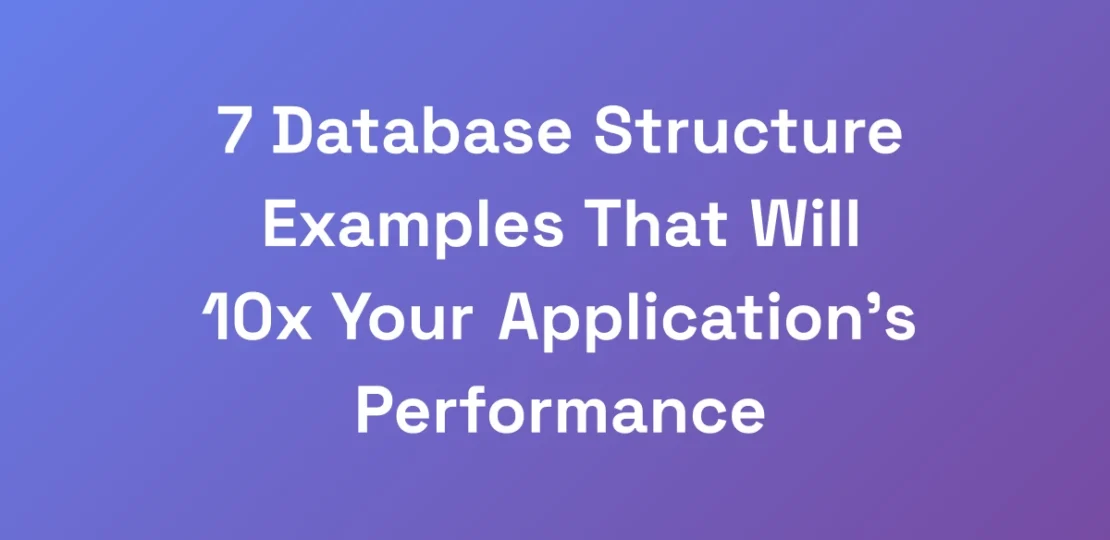7 Database Structure Examples That Will 10x Your Application’s Performance
April 6, 2025 | by [email protected]

Introduction
We’ve all been there. You’ve poured countless hours into building an application, only to watch its performance lag behind competitors. It’s frustrating, right?
The real culprit? A poorly designed database structure. It’s the silent killer of your application’s performance, draining your resources without you even realizing it.
But here’s the kicker: the right database structure can literally 10x your application’s performance without adding a single server. Imagine scaling effortlessly, serving millions of users seamlessly, and outpacing your competition—all because of how you structured your database.
In this guide, we’re going to dive deep into seven game-changing database structure examples that can transform your application’s efficiency. We’ll break down each structure, explore real-world examples, and equip you with actionable tips to implement these strategies effectively.
Are you ready to supercharge your application’s performance? Let’s get started.
Understanding Database Structures: The Foundation of Modern Applications
Let me tell you something that took us years to figure out—the database structure is the silent killer of application performance. We’ve seen countless startups blow millions on scaling when their real problem was a poorly designed database design basics.
Here’s the truth: the right database structure can literally 10x your application’s performance without adding a single server. It’s not about the servers; it’s about how you organize and manage your data.
The Critical Role of Database Structures in Modern Applications
Modern applications rely heavily on databases to store, retrieve, and manage data. A well-structured database ensures that data is accessible, consistent, and reliable.
Think of your database as the engine of your application. A powerful engine propels a car efficiently, while a poorly maintained one leads to breakdowns and poor performance.
Impact of Database Design on Performance and Scalability
Database design directly influences how quickly your application can process requests and scale to handle more users.
For instance, a normalized database minimizes redundancy, making updates faster and more efficient. On the flip side, denormalized structures can speed up read operations, essential for high-traffic applications.
Key Components of Database Structures
Understanding the key components of database structures is crucial for optimizing performance:
- Tables: The fundamental units where data is stored.
- Indexes: Enhance data retrieval speed.
- Relationships: Define how tables interact with each other.
- Schemas: Organize and structure the database logically.
Common Database Structure Patterns
There are several common patterns in database structures, each suited to different types of applications:
- Relational Schema: Ideal for applications requiring structured data and complex queries.
- Star Schema: Perfect for analytical and reporting purposes.
- Snowflake Schema: An extension of the star schema, offering more normalization.
- NoSQL Structures: Best for unstructured or semi-structured data.
Evolution of Database Structures in Modern Architecture
Database structures have evolved significantly to meet the demands of modern applications. From traditional relational databases to advanced NoSQL and NewSQL solutions, the landscape is diverse and continually advancing.
Today, we see a blend of these structures in hybrid models, providing both the consistency of relational databases and the flexibility of NoSQL systems.
The Relational Database Structure: A Time-Tested Foundation
Listen, we know NoSQL is sexy right now, but here’s why relational databases still dominate the market: they’re battle-tested money-makers. When Instagram scaled to a billion users, guess what they were running on? PostgreSQL.
The secret isn’t just in the technology—it’s in the structure. We’re going to show you the exact patterns that make relational databases the backbone of companies doing billions in revenue, and how you can implement these same structures in your business.
Anatomy of a Relational Database Structure
A relational database organizes data into tables, each consisting of rows and columns.
Each table represents an entity, and each row corresponds to a record, while columns represent the attributes of that entity.
This structure ensures data is stored logically and can be easily queried using SQL (Structured Query Language).
Normalization Techniques and Their Impact
Normalization is the process of organizing data to reduce redundancy and improve data integrity.
By dividing large tables into smaller, related tables, normalization minimizes duplication and ensures that updates, inserts, and deletions propagate correctly.
This leads to more efficient data management and faster query performance.
Primary and Foreign Key Relationships
Primary keys uniquely identify each record within a table, ensuring that no duplicate records exist.
Foreign keys establish relationships between tables, allowing data to be linked across different entities.
These relationships are fundamental for maintaining data consistency and enabling complex queries.
Indexing Strategies for Performance
Indexes significantly speed up data retrieval by providing quick access paths to records. Effective database performance optimization strategies involve creating indexes on columns that are frequently used in WHERE clauses, JOIN operations, and ORDER BY statements.
However, over-indexing can lead to increased storage usage and slower write operations, so it’s crucial to balance indexing needs.
Real-world Implementation Examples
Consider an e-commerce platform using a relational database to manage products, customers, and orders.
By properly structuring tables and relationships, the platform can efficiently handle millions of transactions daily, ensuring quick response times and reliable data integrity.
Another example is a financial services application using PostgreSQL to manage complex transactions and reporting, leveraging relational structures for accuracy and performance.
Common Pitfalls and How to Avoid Them
One common pitfall is inadequate normalization, leading to data redundancy and inconsistencies.
Another is improper indexing, which can either slow down queries or bloat the database.
To avoid these issues, implement thorough normalization techniques and regularly review and optimize your indexing strategies based on query performance insights.
Star Schema: The Ultimate Structure for Analytics
If you’re dealing with analytics, this is your money maker. The star schema isn’t just another database structure—it’s a profit multiplier for data-driven businesses.
We’ve seen companies cut their query times from hours to seconds just by implementing this correctly. But here’s what nobody tells you: the real power isn’t in the structure itself, but in how you optimize it for your specific use case.
Let us show you exactly how to do it.
Core Components of Star Schema
The star schema consists of fact tables and dimension tables, structured in a way that resembles a star.
Fact Tables: These contain measurable data, such as sales figures or transaction amounts.
Dimension Tables: These provide context to the facts, including data like date, product, or customer details.
Fact Tables vs. Dimension Tables
Fact tables are usually large and contain quantitative data. They are at the center of the star schema.
Dimension tables, on the other hand, are usually smaller and contain descriptive attributes that allow for easier data analysis and reporting.
This separation ensures that queries can efficiently aggregate facts based on various dimensions.
Optimization Techniques for Star Schema
To optimize a star schema, focus on the following techniques:
- Denormalization of Dimension Tables: Simplifies queries and reduces the need for complex joins.
- Partitioning Fact Tables: Enhances query performance by dividing large tables into manageable segments.
- Using Surrogate Keys: Simplifies relationships and improves join performance.
When to Choose Star Schema
The star schema is ideal for applications that require extensive data analysis, reporting, and business intelligence.
If your application relies heavily on aggregating data from multiple dimensions, the star schema can provide the necessary performance enhancements.
Examples include retail sales analysis, financial reporting, and customer behavior tracking.
Implementation Best Practices
When implementing a star schema, adhere to these best practices:
- Clearly Define Fact and Dimension Tables: Ensure that each table has a specific role to avoid confusion and redundancy.
- Maintain Consistent Naming Conventions: Facilitates easier management and understanding of the schema.
- Optimize Data Types: Use appropriate data types to enhance storage efficiency and query performance.
- Implement Robust Indexing: Improves data retrieval speeds for both fact and dimension tables.
Performance Monitoring and Tuning
Regularly monitor the performance of your star schema to identify and resolve bottlenecks.
Use tools like query analyzers and database performance monitors to track key metrics such as query response times and resource utilization.
Based on the insights gathered, fine-tune your schema by adjusting indexes, partitioning tables, and optimizing queries to maintain optimal performance.
Snowflake Schema: Refining the Star for Greater Efficiency
When you think the star schema is the pinnacle of data structuring for analytics, think again. Enter the snowflake schema, a refined version that takes normalization a step further.
This structure not only maintains the benefits of the star schema but also reduces data redundancy, making your analytics even more efficient.
What is a Snowflake Schema?
The snowflake schema is a variation of the star schema where dimension tables are further normalized into multiple related tables.
This creates a more complex, snowflake-like structure that can handle additional data granularity.
Benefits of Snowflake Schema
- Reduced Data Redundancy: Minimizes duplication by normalizing dimension tables.
- Improved Data Integrity: Ensures consistency across related tables.
- Enhanced Query Performance: While slightly more complex, it can lead to more efficient queries in certain scenarios.
When to Use Snowflake Schema
The snowflake schema is best suited for environments where data integrity and detailed analytics are paramount.
Industries like finance and healthcare, where data accuracy is critical, can benefit significantly from this structure.
Implementing Snowflake Schema
To implement a snowflake schema effectively:
- Normalize Dimension Tables: Break down large dimension tables into smaller, related tables.
- Maintain Clear Relationships: Use foreign keys to link related tables, ensuring data integrity.
- Optimize Join Paths: Design the schema to facilitate efficient joins, reducing query response times.
Case Study: Financial Services
A leading financial institution implemented a snowflake schema to manage its vast array of transaction data.
By normalizing their dimension tables, they achieved a 30% reduction in storage costs and a 20% improvement in query performance.
This allowed them to generate detailed financial reports more quickly, enhancing decision-making processes.
Common Challenges and How to Avoid Them
One challenge with the snowflake schema is its complexity, which can make it harder to manage and understand.
To overcome this, invest in comprehensive documentation and training for your team to ensure everyone understands the schema structure.
Additionally, leverage database management tools that support snowflake schemas to simplify maintenance and optimization tasks.
NoSQL Databases: Flexibility and Scalability Unleashed
While relational databases are powerful, they aren’t always the best fit for every scenario. Enter NoSQL databases, the champions of flexibility and scalability.
We’ve seen businesses thrive by adopting NoSQL for applications that handle massive volumes of unstructured or semi-structured data.
Let’s explore how you can leverage NoSQL to turbocharge your application’s performance.
Types of NoSQL Databases
NoSQL databases come in various types, each tailored to specific data storage and retrieval needs:
- Document Stores: Store data in JSON-like documents, allowing for flexible schemas. Examples include MongoDB and Couchbase.
- Key-Value Stores: Handle large volumes of data through simple key-value pairs. Redis and DynamoDB are popular options.
- Columnar Databases: Optimize for read-heavy operations, storing data in columns. Cassandra and HBase are notable examples.
- Graph Databases: Excel at managing complex relationships between data points. Neo4j and Amazon Neptune are leading choices.
For a comprehensive view of how different databases rank in popularity and usage, check out the latest DB-Engines ranking.
Advantages of NoSQL Databases
- Scalability: Easily scale horizontally to handle growing data volumes and user loads.
- Flexibility: Accommodate diverse data types and evolving schemas without significant restructuring.
- High Performance: Optimized for specific use cases, leading to faster data retrieval and processing.
When to Choose NoSQL Over Relational
NoSQL databases shine in scenarios where:
- Handling Large Volumes of Unstructured Data: Applications like social media platforms and IoT systems benefit from NoSQL’s flexibility.
- Needing High Throughput and Low Latency: Real-time applications, such as gaming and financial trading, require the speed that NoSQL offers.
- Requiring Horizontal Scalability: Startups and rapidly growing businesses that need to scale seamlessly find NoSQL ideal.
Real-World Examples of NoSQL Implementation
Consider Netflix, which uses Cassandra for its high availability and scalability needs, enabling seamless streaming to millions of users worldwide.
Another example is Amazon DynamoDB, powering the backend of Amazon’s e-commerce platform, handling massive transaction volumes with ease.
The flexibility of MongoDB has also been leveraged by startups to rapidly develop and iterate on their applications without being bogged down by rigid schemas.
For those looking for cost-effective solutions, check out the 7 best budget-friendly databases to use in 2024.
Best Practices for Optimizing NoSQL Databases
To get the most out of your NoSQL database, follow these best practices:
- Understand Your Data: Choose a NoSQL type that aligns with your data structure and access patterns.
- Design for Scale: Plan your data distribution and replication strategies to ensure high availability and performance.
- Optimize Queries: Leverage indexing and efficient query design to maximize retrieval speeds.
- Monitor Performance: Use monitoring tools to track database performance and identify areas for improvement.
Challenges and How to Overcome Them
One major challenge with NoSQL databases is ensuring data consistency, especially in distributed systems.
To address this, implement robust data validation and use consistency models that align with your application’s needs.
Another challenge is managing schema evolution. While NoSQL offers flexibility, it’s essential to have a strategy for handling schema changes to prevent data inconsistencies and application errors.
Investing in automated tools and thorough testing can help mitigate these challenges, ensuring your NoSQL implementation remains robust and efficient.
Columnar Databases: Mastering Big Data Analytics
When it comes to big data analytics, columnar databases are the unsung heroes. They’re designed to handle large-scale data analytics with remarkable efficiency.
We’ve witnessed businesses leverage columnar databases to manage terabytes of data effortlessly, driving insightful analytics and informed decision-making.
Let’s break down how you can harness the power of columnar databases to elevate your application’s performance.
Understanding Columnar Storage
Unlike traditional row-oriented databases, columnar databases store data by columns rather than rows.
This means that data for each column is stored contiguously, enhancing data retrieval speeds for analytical queries that often access a subset of columns.
Popular columnar databases include Apache Cassandra, Amazon Redshift, and Google BigQuery.
Benefits of Columnar Databases
- Fast Query Performance: Optimized for read-heavy operations, making them ideal for analytics and reporting.
- Efficient Data Compression: Columnar storage allows for higher compression rates, reducing storage costs.
- Scalability: Easily handle large datasets by distributing data across multiple nodes.
Use Cases for Columnar Databases
Columnar databases are best suited for scenarios involving extensive data analysis, such as:
- Business Intelligence: Facilitates quick generation of reports and dashboards.
- Data Warehousing: Supports large-scale data storage and retrieval for analytics.
- Real-Time Analytics: Enables real-time data processing and insights generation.
Implementing Columnar Databases Effectively
To implement columnar databases effectively, consider the following:
- Schema Design: Organize your schema to optimize for the most frequent query patterns.
- Indexing: Use indexing strategies that complement columnar storage, such as bitmap indexes.
- Data Partitioning: Divide data into partitions based on usage patterns to enhance query performance.
- Resource Allocation: Allocate sufficient resources to handle large-scale data operations without bottlenecks.
Case Study: Big Data Analytics at Scale
A leading retail chain implemented a columnar database to manage and analyze its vast transactional data.
By switching to a columnar structure, they reduced their query processing time from minutes to mere seconds, enabling real-time inventory management and dynamic pricing strategies.
This transformation not only improved operational efficiency but also provided actionable insights that drove a 15% increase in sales.
Overcoming Common Challenges
One of the main challenges with columnar databases is optimizing write performance, as they are primarily designed for read-intensive operations.
To mitigate this, implement batch processing for data inserts and updates, ensuring that write operations do not hamper read performance.
Another challenge is managing storage efficiently. Leveraging advanced compression techniques and partitioning strategies can help maintain optimal storage usage while maximizing performance.
Graph Databases: Navigating Complex Relationships
In applications where relationships and connections are paramount, graph databases are the go-to solution. They excel in managing and querying intricate data relationships with ease.
From social networks to fraud detection systems, graph databases provide the flexibility and performance needed to navigate complex data landscapes.
Let’s explore how you can integrate graph databases to enhance your application’s performance.
What Are Graph Databases?
Graph databases are designed to represent and traverse relationships between data points efficiently.
They consist of nodes (entities), edges (relationships), and properties (attributes), creating a flexible and interconnected data model.
Popular graph databases include Neo4j, Amazon Neptune, and Microsoft Azure Cosmos DB.
Key Benefits of Graph Databases
- Efficient Relationship Traversal: Navigate complex relationships with minimal latency.
- Flexible Data Modeling: Easily adapt to evolving data structures without rigid schemas.
- High Performance for Connected Data: Optimized for queries that involve multiple related entities.
Use Cases for Graph Databases
Graph databases are ideal for applications that require deep relationship insights, such as:
- Social Networks: Manage and analyze user connections and interactions.
- Fraud Detection: Identify suspicious patterns and relationships in transactional data.
- Recommendation Engines: Provide personalized recommendations based on user behavior and preferences.
Implementing Graph Databases Effectively
To harness the power of graph databases, follow these implementation strategies:
- Design a Clear Data Model: Define nodes and relationships that accurately represent your data and use cases using top powerful data modeling tools.
- Optimize Query Performance: Use indexing and query optimization techniques tailored to graph structures.
- Leverage Native Graph Query Languages: Utilize languages like Cypher (Neo4j) or Gremlin (Apache TinkerPop) for efficient querying.
- Ensure Scalability: Choose a graph database that scales horizontally to handle growing data volumes and query loads.
Case Study: Social Media Platform
A prominent social media platform integrated Neo4j to manage and analyze user relationships and interactions.
By leveraging graph structures, they achieved real-time recommendations and enhanced user engagement through personalized content.
The platform saw a 25% increase in daily active users and a significant boost in user satisfaction metrics.
Addressing Common Challenges
One common challenge with graph databases is handling large-scale graphs, which can lead to performance issues.
To address this, implement sharding strategies and distribute the graph across multiple nodes, ensuring balanced load distribution and efficient query processing.
Another challenge is integrating graph databases with existing systems. Utilizing robust APIs and middleware can facilitate seamless integration and data exchange between different database systems.
NewSQL Databases: Combining the Best of Both Worlds
What if you could have the scalability of NoSQL and the ACID compliance of relational databases? Enter NewSQL databases, the hybrid solution bridging the gap between traditional SQL and modern NoSQL systems.
NewSQL databases offer the transactional integrity and familiarity of SQL while providing the horizontal scalability necessary for today’s demanding applications.
Let’s uncover how NewSQL can elevate your application’s performance.
What Are NewSQL Databases?
NewSQL databases are a class of modern relational databases that aim to provide the same scalable performance of NoSQL systems while maintaining the robust transactional capabilities of traditional SQL databases.
Examples include Google Spanner, CockroachDB, and VoltDB.
Benefits of NewSQL Databases
- Scalable Performance: Handle large-scale operations with ease through horizontal scaling.
- Transactional Integrity: Maintain ACID properties, ensuring reliable and consistent transactions.
- SQL Compatibility: Utilize familiar SQL syntax and tools, reducing the learning curve for developers.
Use Cases for NewSQL Databases
NewSQL databases are perfect for applications that require both high performance and strict data integrity, such as:
- Financial Transactions: Ensure accurate and consistent transaction processing.
- E-commerce Platforms: Manage large volumes of transactions and inventory data efficiently.
- Real-Time Analytics: Provide up-to-the-minute insights without compromising on data integrity.
Implementing NewSQL Databases Effectively
To maximize the benefits of NewSQL databases, consider these implementation tips:
- Assess Your Scaling Needs: Determine if your application requires horizontal scaling capabilities that NewSQL offers.
- Leverage SQL Familiarity: Utilize existing SQL expertise within your team to streamline development and maintenance.
- Optimize Sharding Strategies: Efficiently distribute data across multiple nodes to enhance performance and availability.
- Monitor and Tune Performance: Regularly track database performance and make necessary adjustments to maintain optimal efficiency.
Case Study: Global Financial Services
A global financial institution adopted Google Spanner to manage its international transaction processing.
By leveraging Spanner’s horizontal scaling and strong consistency guarantees, they achieved seamless transaction processing across multiple regions.
The result was a 40% improvement in transaction speed and enhanced data reliability, crucial for maintaining customer trust and regulatory compliance.
Conclusion
We’ve journeyed through seven powerful database structure examples that can transform your application’s performance.
From the steadfast reliability of relational databases to the flexible scalability of NoSQL, and the hybrid prowess of NewSQL, each structure offers unique advantages tailored to specific needs.
Implementing the right database structure is not just a technical decision—it’s a strategic move that can propel your application to new heights.
Don’t let a poorly designed database hold you back. Assess your application’s needs, choose the structure that aligns with your goals, and watch your performance soar.
Ready to take your application to the next level? Start by evaluating your current database design and explore how these structures can make a difference SEO optimization automation.
Have questions or experiences to share? Let’s discuss in the comments below. Together, we can build more efficient, high-performing applications using auto SEO tools.
RELATED POSTS
View all


